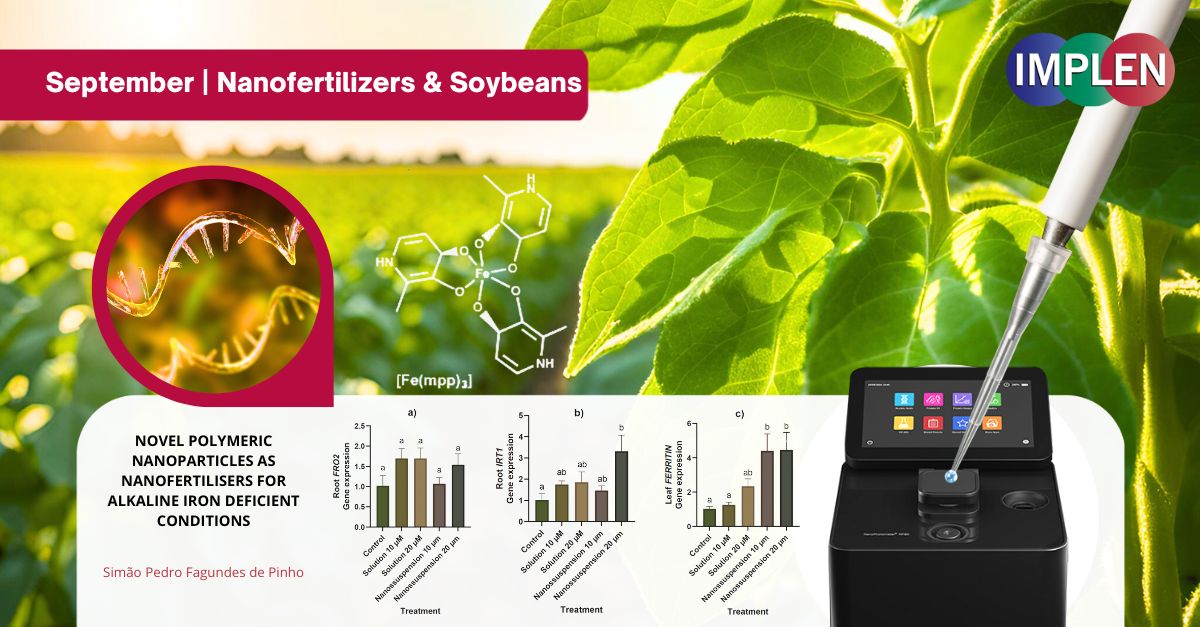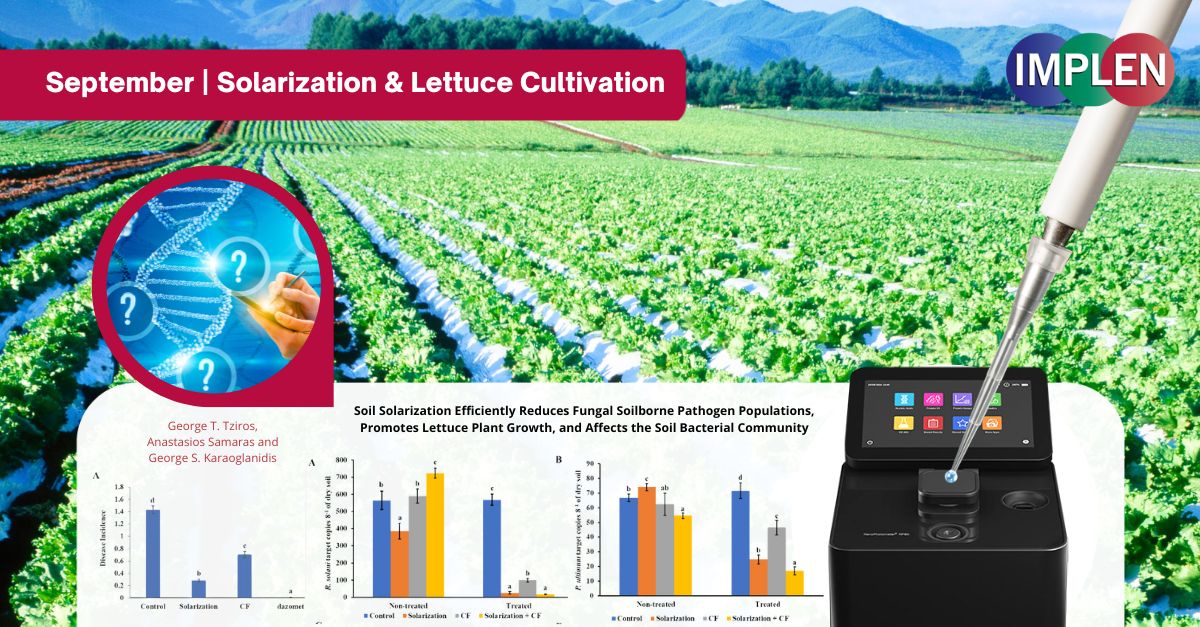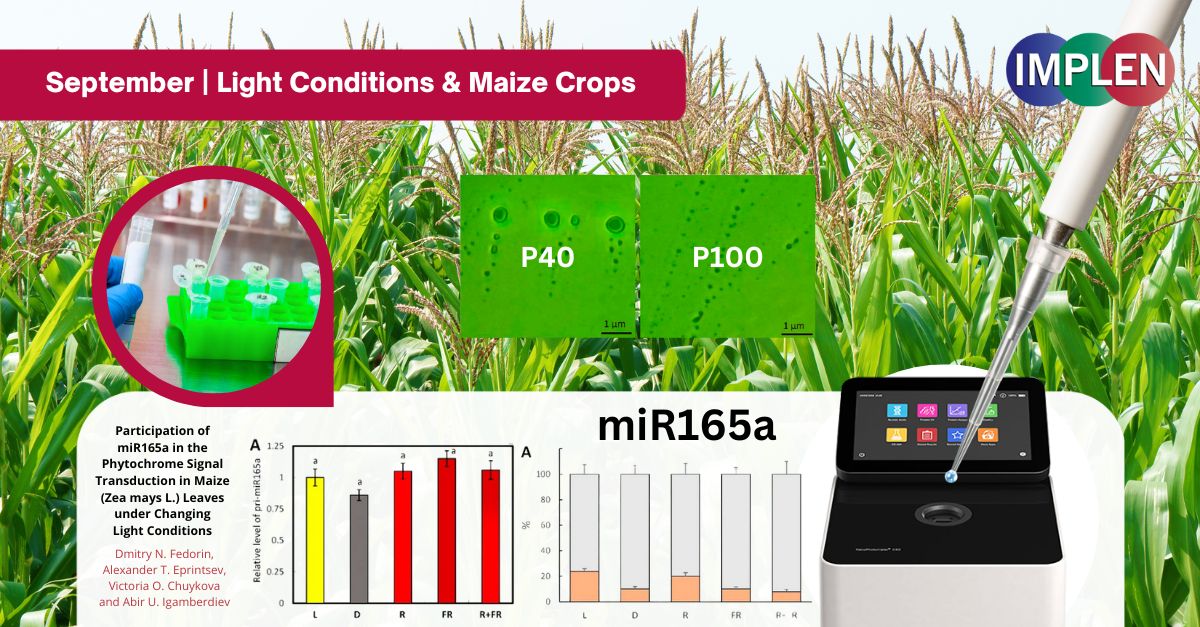Implen Journal Club | September Issue |
|
Breaking New Ground: Advanced Techniques in Developing Nanofertilizers for Iron-Deficient SoilsIn the first issue of our Fall Harvest Edition, we're exploring the innovative study titled "Novel Polymeric Nanoparticles as Nanofertilisers for Alkaline Iron-Deficient Conditions" by Simão Pedro Fagundes de Pinho. This research is particularly relevant as we approach the harvest season, a critical time when optimizing crop yield and quality is at the forefront of agricultural priorities. The study addresses Iron Deficiency Chlorosis (IDC), a common issue in crops like soybeans grown in alkaline soils, which affects plant health and reduces yields—a significant concern during the harvest period. The research introduces novel polymeric nanoparticles (NPs) loaded with 3,4-hydroxy-pyridinones (3,4-HPO) iron(III) chelates as nanofertilizers. These NPs provide a controlled and sustainable release of iron, enhancing plant health and chlorophyll content, and are positioned as a superior alternative to traditional iron chelates like EDTA, which pose environmental risks due to poor biodegradability. As the harvest season emphasizes maximizing productivity, the findings from this study suggest that such nanofertilizers could significantly boost crop performance, aligning with our goals of achieving higher yields and better crop quality sustainably. This innovative approach could represent a paradigm shift in fertilization practices, offering a solution that integrates environmental responsibility with enhanced agricultural productivity. The Implen NanoPhotometer® was used in this study to determine the quantity and quality of extracted RNA. |
|
Harnessing the Sun for a Healthier Harvest: Solarization Shines in Lettuce CultivationIn the next issue, we are bringing in this harvest season by introducing a study recently published by Tziros et al. in the journal of biology that focused on methods to reduce harmful soil fungi in lettuce cultivation. The study evaluated soil solarization, chemical disinfestation, and biofungicide application. Solarization, which involves covering soil with clear plastic to harness solar heat, was identified as the most effective and sustainable method. It significantly reduced populations of harmful fungi such as Rhizoctonia solani, Pythium ultimum, Fusarium oxysporum, and Fusarium equiseti, leading to decreased disease incidence and enhanced plant growth, resulting in healthier and more robust lettuce by harvest. The study also assessed the impact of these treatments on soil bacterial communities. Solarization increased beneficial bacteria like Firmicutes while reducing Proteobacteria and Actinobacteria. Chemical disinfestation showed mixed effects, and the biofungicide had minimal impact on the main bacterial phyla. As we enter the harvest season, these findings highlight the benefits of soil solarization as a healthier, more sustainable option. This method supports plant growth and a balanced microbial environment, ensuring that crops are not only abundant but also of high quality, aligning well with our goals for a successful harvest. The Implen NanoPhotometer® was used in this study for DNA quantification. |
|
Illuminating Maize: How Light Signals Drive Growth During the Fall HarvestNext issue is focusing on how plants like maize adapt to changing light conditions, which is crucial for maximizing crop yields. A study recently published by Fedorin et. al. explored how a small molecule called miR165a helps maize plants respond to different light conditions by affecting gene activity. miR165a works with a protein called AGO10 to form a complex that can break down specific messenger RNAs (mRNAs), which are crucial for gene expression. When maize plants are exposed to red light, the active form of a light-sensing protein called phytochrome B increases the level of this miR165a complex, leading to the breakdown of target mRNAs and influencing the plant’s growth and development. This study identified two types of tiny vesicles in maize leaves, labeled P40 and P100, which transport miR165a. P40 vesicles are larger, while P100 vesicles are smaller. Under red light, phytochrome B redistributes miR165a, increasing its amount in P40 vesicles and decreasing it in P100 vesicles. Typically, miR165a is found on the surface of these vesicles, but its location can shift with different light conditions. The interaction between light, miR165a, and phytochrome B allows maize plants to adjust their growth and metabolism in response to the changing light environment. Understanding these mechanisms could help farmers and researchers develop strategies to optimize crop performance, especially during critical seasons like the fall harvest, where adapting to light conditions can significantly impact yields. The NanoPhotometer® C40 was used in this study for the quantitative assessment of the content of nucleic acids in samples isolated from the P40 and P100 vesicle fractions and their purity. |
|
Probiotics Meet Oktoberfest: Exploring the Future of Craft Beer!As Oktoberfest kicks off, we thought it would be fitting to explore the fascinating intersection of probiotics and beer. In this special edition, we delve into the study by Lucas Borges Martins da Silva et al., which offers exciting insights into how probiotics can survive and thrive in craft beers, particularly those rich in hops—a key ingredient in the beers that make Oktoberfest such a celebrated event. This research highlights the survival of the F19 probiotic strain in different beer formulations with varying hop concentrations, offering potential health benefits while retaining the beer's essential sensory qualities. With the focus on yeasts like Saccharomyces cerevisiae and non-traditional strains like Kveik, combined with the challenges of high hop content, the study showed how craft beers could evolve to not only provide distinct flavors but also contribute to wellness through probiotics. The concentration, purity, and quality of the extracted DNA and RNA samples were assessed using the NanoPhotometer® N60. |
©2024 Implen. All rights reserved.



